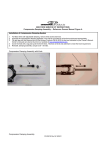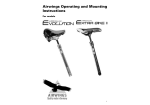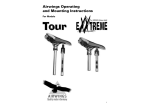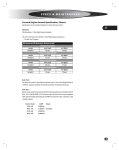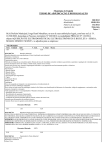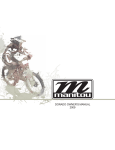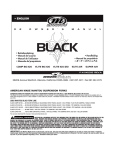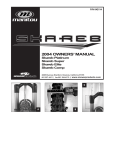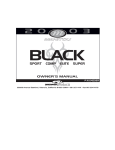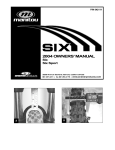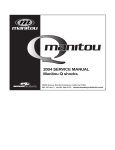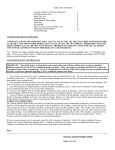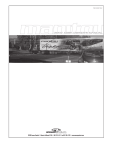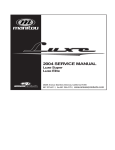Download AP3308 2007 FORKS Final 5-30-06.qxd
Transcript
• ENGLISH MANITOU SUSPENSION FORKS CONGRATULATIONS ON CHOOSING THE LATEST IN SUSPENSION TECHNOLOGY AVAILABLE, A 2007 MANITOU FORK. This fork is fully assembled and ready to be installed onto your bicycle. It comes equipped with either a 1 1/8-inch or a 1.5-inch steerer tube and may also be available in disc brake only or Hex Lock Thru Axle versions. A handlebar-mounted reflector must be used for on-road use, which is not included with your fork. This manual is designed as a comprehensive guide for all 2007 Manitou fork models, including TRAVIS, STANCE, GOLD LABEL JUMP SERIES, NIXON, MINUTE, R7, RELIC, SLIVER, SLATE, AND AXEL. All figures and tables are located at the back of this manual. This manual can also be downloaded from the www.answerproducts.com website. GENERAL CONSUMER SAFETY INFORMATION BICYCLING IS A HAZARDOUS ACTIVITY THAT REQUIRES THAT THE RIDER STAY IN CONTROL OF HIS OR HER BICYCLE AT ALL TIMES. ANY FALL FROM YOUR BICYCLE CAN RESULT IN SERIOUS INJURY OR EVEN DEATH. READING THIS MANUAL ENTIRELY AND PROPERLY MAINTAINING YOUR BICYCLE AND SUSPENSION FORK WILL REDUCE THE POSSIBILITY OF INJURY OR POSSIBLE DEATH. PRIOR TO EVERY RIDE, YOU SHOULD CLOSELY EXAMINE YOUR SUSPENSION FORK (AFTER CLEANING) IN BRIGHT SUNLIGHT TO ENSURE THAT NO DAMAGE HAS OCCURRED DURING THE COURSE OF RIDING, TRANSPORTING OR AFTER A FALL. PAY PARTICULAR ATTENTION TO THE CROWN, INNER LEGS, OUTER LEGS, DROPOUTS, BRAKE ARCH AREAS AND “STRESS POINTS” (SUCH AS WELDS, SEAMS, HOLES AND POINTS OF CONTACT WITH OTHER PARTS ETC.) DO NOT RIDE YOUR BICYCLE IF THE FORK SHOWS ANY SIGNS OF BENDING, LEAKING, CRACKING, CREAKING, SQUEAKING, CLUNKING OR ANY OTHER UNFAMILIAR NOISES, OR IF IT IS MISSING ANY OF THE ORIGINALLY SUPPLIED COMPONENTS. CONTACT YOUR DEALER OR ANSWER PRODUCTS CUSTOMER SERVICE AT (800) 423-0273 IF YOU HAVE ANY QUESTIONS CONCERNING THE FUNCTION, INTEGRITY OR CONDITION OF YOUR FORK. ANY MODIFICATIONS NOT AUTHORIZED IN THIS MANUAL SHOULD BE CONSIDERED UNSAFE. IF YOU ARE A MODERATE OR AGGRESSIVE OFF-ROAD RIDER, OR RIDE AT LEAST THREE TIMES A WEEK OVER ROUGH TERRAIN, ANSWER RECOMMENDS RETURNING YOUR SUSPENSION FORK TO ANSWER PRODUCTS EVERY 2 YEARS FOR A THOROUGH INSPECTION. TAKE YOUR FORK TO A MANITOU AUTHORIZED DEALER WHO CAN ARRANGE FOR SHIPMENT TO ANSWER PRODUCTS, PHONE # (800) 423-0273. REFLECTORS MANITOU FORKS ARE DESIGNED FOR OFF-ROAD USE, AND AS SUCH, THEY DO NOT COME WITH PROPER REFLECTORS FOR ON-ROAD USE. HAVE YOUR DEALER OR MECHANIC INSTALL PROPER REFLECTORS TO MEET THE CONSUMER PRODUCT SAFETY COMMISSION’S (C.P.S.C.) REQUIREMENTS FOR BICYCLES IF YOUR FORK IS GOING TO BE USED ON PUBLIC ROADS AT ANY TIME. IF YOU HAVE QUESTIONS REGARDING C.P.S.C. REFLECTORS, PLEASE CONTACT YOUR DEALER. IT IS CRITICAL THAT YOU SELECT AND USE THE SUSPENSION FORK THAT IS APPROPRIATE FOR YOUR ANTICIPATED RIDING STYLE, THAT YOU USE THE FORK PROPERLY AND FOLLOW THE WARNINGS CONTAINED IN THE OWNER’S MANUAL, REGARDLESS OF THE RIDING STYLE. FAILURE TO PROPERLY MATCH THE FORK TO YOUR FRAME OR RIDING STYLE COULD CAUSE THE FORK TO FAIL, RESULTING IN A LOSS OF BICYCLE CONTROL AND POSSIBLY SERIOUS INJURY OR DEATH TO THE RIDER. IN ADDITION, AN IMPROPER COMBINATION OF FRAME AND FORK FOR THE INTENDED CATEGORY WILL VOID THE FORK'S WARRANTY. VISIT OUR WEBSITE AT WWW.ANSWERPRODUCTS.COM/ IU FOR MORE DETAILED INFORMATION AND GUIDANCE ON FORK SELECTION FOR YOUR RIDING STYLE. YOU SHOULD ONLY ATTACH GENERATORS, RACKS AND DISC BRAKES TO THE DESIGNATED MOUNTING POINTS PROVIDED ON THE FORKS. NEVER MAKE ANY MODIFICATION TO YOUR FORK TO ATTACH ANY EQUIPMENT. THERE IS A HEIGHTENED LEVEL OF VOLUNTARY RISK ASSOCIATED WITH FREERIDING, DIRT JUMPING AND DOWNHILLING. LARGER STUNTS/JUMPS MEAN MORE POTENTIAL FOR EQUIPMENT ISSUES OR PROBLEMS AND THE LIKELIHOOD OF SERIOUS INJURY IS GREATLY INCREASED. LEARN HOW TO PROPERLY RIDE AROUND OBSTACLES ON THE TRAIL OR ROAD. HITTING OBSTACLES SUCH AS CURBS, ROCKS, TREES, ROOTS, HOLES OR SIMILAR OBSTACLES STRAIGHT ON PUTS FORCES ON YOUR FORK IT WAS NOT DESIGNED TO ABSORB. LANDING IMPROPERLY AFTER A JUMP OR DROP ALSO PUTS FORCES ON YOUR FORK IT WAS NOT DESIGNED TO ABSORB. YOU SHOULD ONLY PERFORM JUMPS OR DROPS WHEN A TRANSITION OR DOWN RAMP IS AVAILABLE TO HELP YOUR BICYCLE AND FORK ABSORB THE IMPACT FORCES GENERATED DURING THE LANDING, AND BOTH WHEELS SHOULD SMOOTHLY MAKE CONTACT WITH THE TRANSITION OR DOWN RAMP AT THE SAME TIME. ANY OTHER TYPE OF LANDING IS DANGEROUS, AS IT COULD OVERLOAD THE FRAME OR FORK AND RESULT IN A COMPONENT PART FAILURE AND AN ACCIDENT OR COULD CAUSE YOU TO LOOSE CONTROL OF THE BICYCLE, EVEN WITHOUT A COMPONENT PART FAILURE. THE STEEPNESS AND LENGTH OF THE TRANSITION OR DOWN RAMP DEPENDS ON THE HEIGHT FROM WHICH YOU JUMP OR DROP. EVERY SITUATION IS DIFFERENT FOR EVERY RIDER; CONSULT WITH AN EXPERIENCED RIDER BEFORE ATTEMPTING ANY JUMP OR DROP. FAILURE TO PROPERLY RIDE AROUND OBSTACLES ON THE TRAIL, OR FAILURE TO PROPERLY LAND AFTER A JUMP OR DROP COULD CAUSE YOUR FORKS TO FAIL, RESULTING IN A LOSS OF BICYCLE CONTROL AND, POSSIBLY, SERIOUS INJURY OR DEATH TO THE RIDER. RIDE ONLY IN AREAS SPECIFICALLY DESIGNATED FOR YOUR RIDING STYLE. DO NOT MISUSE OR ABUSE YOUR FORKS. LEARN HOW TO RIDE, AND ALWAYS RIDE WITHIN YOUR ABILITIES. OUT-OF-CONTROL RIDING PUTS THE EQUIVALENT OF YEARS OF HARD USE ON YOUR FORKS AFTER ONLY A FEW RIDES. SOMETIMES THE DAMAGE IS NOT OBVIOUS TO THE USER, BUT COULD HAVE FAILED INTERNAL COMPONENTS OR DAMAGED THE LOAD CARRYING ABILITIES OF THE MATERIALS USED IN THE CONSTRUCTION OF THE FORK. ALL SUSPENSION FORKS REQUIRE REGULAR MAINTENANCE AND REPAIR. THE HARDER YOU RIDE, THE MORE OFTEN YOU MUST INSPECT AND MAINTAIN YOUR FORKS. IF YOUR FORKS START MAKING ANY STRANGE NOISES, CLUNKS, CREAKS, CLICKS, OR FEEL “LOOSE” OR DIFFERENT IN ANY WAY, THEY SHOULD NOT CONTINUE BEING USED, BUT IMMEDIATELY HAVE A CERTIFIED MANITOU SERVICE CENTER INSPECT AND REPAIR THE FORKS BEFORE YOU RIDE AGAIN. INSPECT YOUR FORKS REGULARLY TO SEE THAT THEY ARE NOT BENT, DEFORMED, CRACKED, CHIPPED, NO MATTER HOW SLIGHT, THEY SHOULD NOT CONTINUE TO BE USED, BUT ALSO IMMEDIATELY HAVE A CERTIFIED MANITOU SERVICE CENTER INSPECT AND REPAIR THE FORKS BEFORE BEING USED AGAIN. IDENTIFY YOUR RIDING STYLE It is critical that you select and use the suspension fork that is appropriate for your anticipated riding style, that you use the fork properly and follow all warnings contained in this owner’s manual regardless of the riding style. See below for different riding categories. Visit our website at www.answerproducts.com/iu for more detailed information and guidance on fork selection for your riding style. Trekking (TK): Trekking is similar to XC riding but not as aggressive as XC. It involves slower riding, typically on paved and smooth roads, and no riding obstacles such as rocks, roots, or depressions. Cross Country (XC): Also called “marathon riding”. Involves riding along hilly trails where some bumps and smaller obstacles, such as rocks, roots, or depressions, may be encountered. XC RIDING DOES NOT INCLUDE LARGE JUMPS OR DROPS (riding off rocks, fallen trees or ledges) from any height. XC forks must only be used with tires specifically designed for cross country riding. XC forks can be used with disc, rim or linear pull brakes. All Mountain (AM): Riding with more emphasis on aggressive XC riding with larger obstacles and rough terrain. AM RIDING DOES NOT INCLUDE LARGE JUMPS OR DROPS (riding off rocks, fallen trees or ledges) from any height. These forks should be used only with disc brakes, as well as frames, wheels and other components specifically designed for this riding style. Freeride (FR): This riding style is for skilled riders and involves aggressive slopes, very rough terrain, large obstacles and moderate jumps. Freeride forks should be used only with disc brakes as well as frames, wheels and other components specifically designed for freeriding. Dirt Jumping (DJ) : Also called “Urban Riding”, this type of riding is only for the most skilled riders and involves jumping from one mound of dirt to another and landing smoothly on a downside transition. It also includes riding or jumping over and around man-made or other concrete structures. These forks should be used only with frames, wheels and other components specifically designed for this riding style. 3 Downhill (DH): This discipline is only for professional or highly-skilled riders. It includes use on relatively high jumps (or “drops”) and negotiating larger obstacles such as boulders, fallen trees or holes. These forks should be used only with disc brakes, as well as frames, wheels and other components specifically designed for this riding style. INTENDED USES Visit our website at www.answerproducts.com/iu for more detailed information and guidance on fork selection for your riding style. Trekking Forks for smooth pavement riding. Cross Country Intermediate terrain, expeditions and competition use. DOWNHILL OR FREESTYLE RIDING OR RACING PLACES EXTREME STRESS ON BICYCLES AND THEIR COMPONENTS (LIKE IT DOES RIDERS). REPEATED USE OF A FORK IN DOWNHILL RIDING MAY RESULT IN SUDDEN OR PREMATURE FAILURE OF A BICYCLE OR COMPONENT RESULTING IN SEVERE INJURIES. IF YOU PARTICIPATE IN THESE TYPES OF EVENTS, THE LIFETIME OF THE PRODUCT MAY BE SIGNIFICANTLY SHORTENED DEPENDING UPON THE LEVEL AND AMOUNT OF RACING. THE “NORMAL WEAR” OF A COMPONENT MAY DIFFER GREATLY BETWEEN COMPETITIVE AND NON-COMPETITIVE USES, WHICH IS WHY PROFESSIONAL LEVEL RIDERS OFTEN USE NEW BIKES AND COMPONENTS EACH SEASON AS WELL AS HAVE THEIR BIKES SERVICED BY PROFESSIONAL MECHANICS. REDUCED FORK LIFE All Mountain Riding based with more emphasis on aggressive XC riding with larger obstacles. Freeride Forks for the roughest descents, jumps and drops. Dirt Jumping Suspension for big air, manmade stunts and dual slalom courses. Downhill Forks for aggressive riding and pro downhill racing. THE LIFE OF THIS FORK WILL BE REDUCED IF (1) YOU USE IT MORE THAN THE AVERAGE USER, (2) YOU ARE HEAVIER THAN THE AVERAGE RIDER, (3) THE TERRAIN YOU RIDE ON IS ROUGHER THAN AVERAGE, (4) YOU TEND TO BE HARDER ON COMPONENTS THAN THE AVERAGE RIDER, (5) IT IS INSTALLED OR MAINTAINED IMPROPERLY, (6) IT MUST ENDURE MORE ADVERSE ENVIRONMENTAL CONDITIONS THAN THE AVERAGE FORK (I.E. SWEAT, CORROSIVE MUD, SALTY BEACH AIR ETC.), AND/OR (7) YOU DAMAGE IT IN A CRASH, JUMP OR THROUGH OTHER ABUSE. THE MORE FACTORS YOU MEET, THE MORE ITS LIFE WILL BE REDUCED, HOWEVER IT IS IMPOSSIBLE TO SAY HOW MUCH. PRESS FIT CROWNS INTENDED USE FORK MODEL AXEL • GOLD LABEL JUMP SERIES • • • MINUTE NIXON R7 RELIC SLATE SLIVER STANCE TRAVIS THE STEERER TUBE (ON BOTH SINGLE AND DOUBLE CROWN FORKS) AND STANCHIONS (INNER LEGS ON SINGLE CROWN FORKS) ARE PRESS FIT AT THE FACTORY AND SHOULD NEVER BE REMOVED FROM THE CROWN. PRESSING THEM OUT WILL PERMANENTLY DAMAGE THE CROWN BEYOND REPAIR AND RENDER IT UNSAFE FOR ANY CONTINUED USE. NEVER ATTEMPT TO THREAD A THREADLESS STEERER TUBE. CUTTING THREADS WILL WEAKEN THE STEERER TUBE AND CAUSE AN UNSAFE CONDITION. OBTAIN THE CORRECT CROWN/STEERER FROM YOUR DEALER, OR CONTACT ANSWER CUSTOMER SERVICE AT (800) 423-0273. • • • • REPLACEMENT OF THE ENTIRE CROWN/STEERER ASSEMBLY MUST BE DONE TO INCREASE STEERER TUBE LENGTHS OR CHANGE DIAMETERS. REMOVING AND REPLACING THE STEERER TUBE WILL RESULT IN AN UNSAFE CONDITION AND SHOULD NEVER BE DONE. • • • • • INSTALLATION INSTRUCTIONS • Please see the website at www.answerproducts.com for additional information. “DOWNHILL”, “FREESTYLE” OR COMPETITIVE RIDING TO RIDE DOWNHILL AT HIGH SPEED OR IN COMPETITION IS TO VOLUNTARILY ASSUME A VERY HIGH RISK, AND DOWNHILL OR FREESTYLE RIDING CAN LEAD TO SERIOUS ACCIDENTS. SPEEDS “DOWNHILLING” CAN REACH SPEEDS SEEN ON MOTORCYCLES WITH SIMILAR HAZARDS AND RISKS. WEAR APPROPRIATE SAFETY GEAR, INCLUDING A FULL FACE HELMET, FULL FINGER GLOVES AND BODY ARMOR. HAVE YOUR BICYCLE INSPECTED BY A QUALIFIED MECHANIC BEFORE EVERY EVENT AND BE SURE IT IS IN PERFECT WORKING CONDITION. ROUTINE AND THOROUGH MAINTENANCE IS EVEN MORE CRITICAL THAN WITH A BIKE NOT USED FOR DOWNHILLING OR FREESTYLE RIDING. CONSULT WITH EXPERT RIDERS AND RACE OFFICIALS ON CONDITIONS AND EQUIPMENT ADVISABLE AT THE SITE WHERE YOU PLAN TO RIDE DOWNHILL OR FREESTYLE. SUSPENSION AND DISK BRAKES MAY INCREASE THE HANDLING CAPABILITIES AND COMFORT OF YOUR BICYCLE AND MAY ALLOW YOU TO RIDE FASTER, BUT DO NOT CONFUSE THE ENHANCED CAPABILITIES OF A SUSPENSION BIKE WITH DISK BRAKES WITH YOUR OWN CAPABILITIES. INCREASING YOUR SKILL WILL TAKE TIME AND PRACTICE. PROCEED CAREFULLY UNTIL YOU ARE SURE YOU ARE COMPETENT TO HANDLE THE FULL CAPABILITIES OF YOUR BIKE. WHILE THE RUGGED APPEARANCE OF MOUNTAIN BIKES AND THESE DISK BRAKES MIGHT SUGGEST THEY ARE INDESTRUCTIBLE, THEY ARE NOT. CERTAINLY THEY ARE TOUGH AND STURDY. 4 Ensure that the proper steerer tube has been delivered on your fork first. The steerer tube may need to be cut to length to fit your bicycle head tube. If you are not familiar with this procedure, or do not have the proper tools to cut the steerer tube, it is recommended that you seek a dealer with a qualified bicycle mechanic to perform the installation. When cutting a steering column of a fork make sure to measure twice before cutting; forks cut too short during installation are NOT covered by the warranty. BREAK-IN Your new fork is designed to break in during your first few rides (about 20 hours total riding time). Prior to break-in, you may notice your fork feels tight and slightly notchy. Following the break-in period, your fork will feel much smoother and will react to bumps much better than when you first put it on your bike. After 20 hours, you may want to recheck adjustments (where applicable) to fine-tune the fork completely. WHENEVER YOU INSTALL ANY NEW COMPONENT ON YOUR BIKE MAKE SURE YOU THOROUGHLY TRY IT OUT CLOSE TO HOME (WITH YOUR HELMET) WHERE THERE ARE NO OBSTACLES, TRAFFIC OR OVERLY CHALLENGING TERRAIN. MAKE SURE EVERYTHING IS WORKING PROPERLY BEFORE GOING OFF ON A RIDE OR TO A RACE. FORK INSTALLATION – SINGLE CROWN FORKS 1. Remove the old fork from your bicycle. 2. Measure and cut the steerer tube to fit your bicycle head tube (see CAUTION above). You can use your old fork as a guide for cutting the steerer tube length. 3. Remove the headset crown race from the old fork and press onto the fork steerer until the race is seated snugly against the top of the crown per the headset manufacturer’s instructions. 4. Clean and grease the headset bearings and races per the headset manufacturer’s instructions. 5. Install the lower bearings (if applicable) on fork crown race per the headset manufacturer’s instructions. 6. Insert the steerer tube into the head tube of the frame. 7. Install the upper bearings, stem spacers, and stem. 8. Install the stem cap and bolt. Tighten the bolt to headset manufacturer’s specifications. 9. Install the handlebars and torque the stem pinch screws or stem clamping system to stem manufacturer’s specifications. 10. Install the brakes and adjust per the brake manufacturer’s instructions. 11. For forks equipped with IT or ClickIt remote lockout levers, install the lever in an easily accessible position and torque to values indicated in Table 6 at the back of this manual. 12. For forks with standard dropouts (non through axle), adjust the front wheel quick release to clear the 0.275” (7 mm) thick secondary catch dropout. The quick release must be tightened to quick release manufacturer’s specifications after it is properly seated into the dropout counter bores. Ensure that there is adequate thread engagement (4 or more threads with the release adjusted to lock). Refer to your bicycle owners manual on the proper use and adjustment of the quick release lever. NOTE: 2007 forks with standard dropouts are equipped with a secondary catch dropout to retain the wheel in the fork in the event the quick release comes loose. 13. To install the hex axle, simply slip the axle into the dropout, small axle hex side first into the large dropout hex. Thread in the set bolt into the small hex side and snug slightly. Push the fork up and down a few times to center the axle and hub and then tighten all pinch bolts (or levers on the QR Hex Axle system) to recommendations found in Table 6. 14. Install the brake cable per manufacturer’s instructions. quick release lever. NOTE: 2007 forks with standard dropouts are equipped with a secondary catch dropout to retain the wheel in the fork in the event the quick release comes loose. 13. To install the hex axle, simply slip the axle into the dropout, small axle hex side first into the large dropout hex. Thread in the set bolt into the small hex side and snug slightly. Push the fork up and down a few times to center the axle and hub and then tighten all pinch bolts (or levers on the QR Hex Axle system) to recommendations found in Table 6. 14. Install the brake cable per manufacturer’s instructions (see WARNING below.) BRAKE CABLE INSTALLATION FAILURE TO PROPERLY ROUTE AND SECURELY ATTACH THE FRONT BRAKE CABLE TO THE FORK CAN CAUSE SERIOUS INJURY OR DEATH. Included with your fork is a small black disc brake cable guide (part no. 066455) that can be attached to the fork to aid in routing the cables to disc brake calipers. The best method we’ve found is to attach the cable so that it runs down the outside of the left fork leg. Make sure the brake line is not crimped and does not touch the tire as the fork moves through its range of travel. WHEN INSTALLING THE WHEEL WITH A PROPERLY INFLATED TIRE, CHECK TO MAKE SURE THE FORK ACHIEVES MINIMUM TIRE CLEARANCE. FAILURE TO CONFORM TO RECOMMENDED TIRE CLEARANCE SPECIFICATIONS MAY CAUSE THE TIRE TO STOP SUDDENLY DURING USE CAUSING PERSONAL INJURY OR DEATH. Measure minimum tire clearance from any point on the profile of the tire upward to the bottom of the brake arch (see Figure A). Compare to Table 1 for minimum brake arch clearance. All figures and tables are located at the back of this manual. Measure the tire at maximum width (see Figure B). Compare with Table 1 for maximum tire width. INITIAL SET-UP MEASURING TRAVEL (the total amount of up and down movement) To determine how much travel your fork has, simply measure the distance from the top of the seal on the lowers (or the bottom of the fork boot) to the bottom of the crown. See Table 2 to determine travel. FORK INSTALLATION – DUAL CROWN FORKS 1. Remove the old fork from your bicycle. 2. Measure and cut the steerer tube to fit your bicycle head tube. You can use your old fork as a guide for cutting the steerer tube length. To determine which upper triple clamp your frame will need see Table 5. 3. Remove the headset crown race from the old fork and press onto the fork steerer until the race is seated snugly against the top of the crown per the headset manufacturer’s instructions. 4. Clean and grease the headset bearings and races per the headset manufacturer’s instructions. 5. Install the lower bearings (if applicable) on fork crown race per the headset manufacturer’s instructions. 6. Insert the steerer tube into the head tube of the frame. 7. Install the upper bearings, stem spacers, upper triple clamp and stem or integrated upper handlebar stem clamp. 8. Install the stem cap and bolt. Tighten the bolt to headset manufacturer’s specifications. 9. Install the handlebars and torque the stem pinch screws or stem clamping system to stem manufacturer’s specifications. Triple clamp, steerer tube, and handlebar bolts (integrated crown/stem models only) should be tightened to recommendations found in Table 6. 10. Install the brakes and adjust per the brake manufacturer’s instructions. 11. Adjust stanchion legs in the upper and lower crowns. The top of the lower clamp must not be more than 15mm from the step-down point in the upper stanchion tube leg. 12. For forks with standard dropouts (non through axle), adjust the front wheel quick release to clear the 0.275” (7 mm) thick secondary catch dropout. The quick release must be tightened to manufacturer’s specifications after it is properly seated into the dropout counter bores. Ensure that there is adequate thread engagement (4 or more threads with the release adjusted to lock). Refer to your bicycle owners manual on the proper use and adjustment of the MEASURING SAG (the amount your suspension compresses due to the weight of your body when in a ntural riding position) To measure sag, you’ll need a tape measure, a pencil, a piece of paper and a helper. 1. Measure the distance from the front axle’s centerline to the bottom of the crown when no one is sitting on the bike and write down this measurement. (Remember the exact locations of the two points because you’ll need to use them later.) 2. Have the rider sit on the bike and measure the distance between the same two points as in step one. It is important to be in the normal riding position (weight centered) with your feet on the pedals. 3. Subtract the second measurement from the first. The resulting measurement is the static sag (see Table 3). 4. On coil forks with preload adjusters, turning the knob clockwise increases spring preload and decreases sag, while turning the knob counterclockwise decreases spring preload and increases sag. 5. On air forks, remove the Schrader air cap located on the top or on the bottom of the left leg and, using a dedicated shock pump (Manitou part #85-4162), inflate the fork with the desired pressure. Be aware that sometimes air systems lose a small amount of pressure when the pump is removed, so you may want to check exactly how much your pump loses by reinstalling it after you have set and checked the pressure. When setting sag on forks featuring IT (Infinite Travel) technology, see “ADJUSTING MAIN SPRING AIR PRESSURE” below. 6. If adjusting the preload or air pressure does not provide the proper sag, you may require a new ride kit. Please see recommended ride kits below. 5 COMPRESSION DAMPING ADJUSTMENT – INTRINSIC DAMPING™ COMPRESSION DAMPING ADJUSTMENTS – PLATFORM PLUS™ Forks equipped with the Intrinsic damping system are designed to be extremely supple in the initial 50% of their travel while still maintaining the bottomless feeling inherent with a traditional SPV damped fork. Turning the red knob at the top of the right fork leg counterclockwise delays Intrinsic’s anti-bottoming properties until the fork is deeper in the stroke. Turning the red knob clockwise will create a more progressive damping effect and make the suspension firmer from mid-stroke to bottom-out. For forks equipped with the Platform Plus damping system, a simple turn of the red knob located on top of the right leg is all that is needed to increase platform effect. Turning the knob clockwise (as you are looking from a rider’s position) increases the amount of platform and bobbing resistance, while turning the knob counterclockwise decreases platform for a more active feel. PLATFORM ADJUSTMENT – SNAP VALVE SPV™ and SPV EVOLVE™ Forks equipped with the FFD damper do not have external compression damping adjustments. With Snap Valve SPV (“Stable Platform Valve” damping) and SPV Evolve damping systems, your suspension’s compression damping characteristics, platform, and position sensitivity can be set with an SPV pump (Manitou part #85-4163). For proper function of your SPV damping system follow this procedure: 1. Start by removing the red SPV air cap located on the top of the right fork leg, as you are looking at the fork from the rider’s position. Using a dedicated SPV pump (Manitou Part #85-4163), inflate the fork to the pressure recommended in Table 7. 2. Check sag per procedure above. 3. Adjust SPV pressure. More pressure will create more compression damping, hold the bike up more and pedal better. Less pressure will create less compression damping, allow more sag, and be more responsive and supple. NOTE: Snap Valve SPV forks will have a much higher platform for a given pressure setting since it is a cross country/marathon specific damper. For the Snap Valve SPV system, we recommend starting with 70 psi (4.8 bar) in both the main spring and the Snap Valve damper leg. Ideal setup with this system will have roughly equal pressures in both the main spring and the Snap Valve damper sides. REBOUND DAMPING ADJUSTMENT DO NOT RUN SPV PRESSURE BELOW 30 PSI (2.04 BAR). PRESSURES BELOW 30 PSI (2.04 BAR) WILL RESULT IN A LACK OF BOTH COMPRESSION AND REBOUND DAMPING AS WELL AS A KNOCKING SENSATION IN THE FORK. MAXIMUM SPV PRESSURE IS 150 PSI (10.2 BAR). 4. Adjust SPV volume (SPV Evolve forks only). With a 16 mm socket wrench or the SPV 16 mm volume adjust socket (part #85-3007), you can adjust the air volume in your SPV Evolve suspension. The volume adjust hex is colored red and is located on top of the right leg. Turning the volume adjuster inwards will create a more progressive damping effect and make the suspension firmer from mid-stroke to bottom-out. Turning the volume adjuster outwards will make the suspension more linear in compression damping and have a softer finish. COMPRESSION DAMPING ADJUSTMENT – TPC+™ For forks equipped with TPC+, a simple turn of the knob located on top of the right leg is all that is needed to add compression damping. Turning the knob clockwise (as you are looking from a rider’s position) increases compression damping, while turning the knob counterclockwise decreases compression damping. Some forks featuring TPC+ may not have external compression adjustments. Please consult the service manual (located at www.answerproducts.com) for further instructions on how to adjust these forks. COMPRESSION DAMPING ADJUSTMENT – TPC LOCKOUT™ and CLICKIT REMOTE LOCKOUT™ For forks equipped with TPC with lockout, a simple turn of the knob located on top of the right leg is all that is needed to add compression damping and activate the lockout. Turning the knob clockwise (as you are looking from a rider’s position) increases compression damping and activates the lockout, while turning the knob counterclockwise decreases compression damping and deactivates the lockout. The last 1/4 turn of the knob activates the lockout, while the initial part of the knob’s travel increases or decreases compression damping. TPC Lockout forks can be upgraded to the ClickIt remote lockout system. ClickIt remote lockout is an “on or off” lockout system designed to be mounted on the handlebar for easier lockout actuation. It is important to note that the ClickIt remote lockout system requires the rider to un-weight the fork before lockout disengagement. When you release the fork from a lockout position, the lockout will not disengage until after the next bump encounter or until the fork is un-weighted. 6 COMPRESSION DAMPING ADJUSTMENTS – FLUID FLOW DAMPING (FFD)™ Rebound adjusters on Manitou forks are located on the bottom of the right fork leg. Turning the knob clockwise (as you are looking at the fork from the bottom) increases rebound damping, while turning the knob counterclockwise decreases rebound damping. ADJUSTING MAIN SPRING AIR PRESSURE Remove the air cap located on either the top or bottom of the left fork leg and, using a dedicated air pump (Manitou Part #85-4162), inflate the fork with the desired pressure. Be aware that sometimes air systems lose a small amount of pressure when the pump is removed, so you may want to check exactly how much your pump loses by reinstalling it after you have set and checked pressure. Forks with Infinite Travel (IT)™ adjustment have their main air spring adjuster at the bottom of the left fork leg. When pressurizing the main spring with IT, you will need to turn your fork /bike upside down (to keep from getting oil inside your air pump), pump to the desired setting, and with the pump still installed, depress the handlebar mounted travel adjuster. This will equalize the two chambers in the fork leg and cause the pressure reading on your pump to drop. Repeat the procedure until the pressure reading on the shock pump, with the handlebar-mounted travel adjuster depressed, reaches the desired pressure. Maximum main spring air pressure is 300 psi (20.4 bar). Consult the website for further instructions if necessary. INFINITE TRAVEL (IT)™ TRAVEL ADJUSTMENT Forks with IT adjustment can be set to anywhere in their travel range by depressing the bar-mounted travel adjust lever, compressing the fork to the desired travel, then releasing the bar-mounted lever. These forks can be set anywhere within their travel range while maintaining a constant spring rate. Changing travel while riding IT forks requires the rider to be proficient with the IT system, as lengthening travel will require you to un-weight the front end of the bike. For sag and air pressure adjustments, please see above recommendations. RAPID TRAVEL WIND DOWN™ To change the travel with Rapid Travel Wind Down, just turn the knob located at the top of the left leg (from a rider’s perspective) clockwise for shorter travel and counterclockwise for longer travel. Use the dial indicator to determine the travel you are in. The number that is at the back of the crown indicates your current travel setting. Do not attempt to activate this travel adjust feature while riding. STAGE 2™ SPRING RATE ADJUSTMENT SYSTEM The Stage 2 spring rate adjustment system is featured on 2007 MINUTE COMP forks only. Much more than just a preload, the Stage 2 adjuster allows the rider to alter the spring rate from a medium to a firm setting. Just turn the knob located at the top of the left leg (from a rider’s perspective) clockwise for a firmer rate and counterclockwise for a lighter rate. MAINTENANCE Your fork requires periodic maintenance, cleaning and inspection. This is because moisture and contamination may build up inside the fork depending on the severity of riding conditions. To maintain top performance, it is recommended that the fork be periodically disassembled, cleaned, dried and re-lubricated. You can download service and tuning instructions on the web at www.answerproducts.com. SUGGESTED SERVICE INTERVALS FOR ALL MANITOU SUSPENSION FORKS NORMAL CONDITIONS Short, Sporadic Rides Long, Frequent Rides Disassemble fork per Service Manual. Clean out casting and replace Semi Bath oil every 6 months. Service FFD, TPC, TPC+, SPV Evolve, Snap Valve SPV, and Intrinsic damping systems by changing the damper oil every year. Grease spring stack as needed. On air fork models, check the oil level sitting on top of the air piston every 2 months per directions found on www.answerproducts.com. Disassemble fork per Service Manual. Clean out casting and replace Semi Bath oil every 4 months. Service FFD, TPC, TPC+, SPV Evolve, Snap Valve SPV, and Intrinsic damping systems by changing the damper oil every year. Grease spring stack as needed. On air fork models, check the oil level sitting on top of the air piston every 6 weeks per directions found on www.answerproducts.com. SEVERE CONDITIONS Short, Sporadic Rides Long, Frequent Rides Disassemble fork per Service Manual. Clean out casting and replace Semi Bath oil every 4 months. Service FFD, TPC, TPC+, SPV Evolve, Snap Valve SPV, and Intrinsic damping systems by changing the damper oil every year. Grease spring stack as needed. On air fork models, check the oil level sitting on top of the air piston every 6 weeks per directions found on www.answerproducts.com. Disassemble fork per Service Manual. Clean out casting and replace Semi Bath oil every 3 months. Service FFD, TPC, TPC+, SPV Evolve, Snap Valve SPV, and Intrinsic damping systems by changing the damper oil every year. Grease spring stack as needed. On air fork models, check the oil level sitting on top of the air piston every 4 weeks per directions found on www.answerproducts.com. BEFORE EVERY RIDE YOU SHOULD: 1. Ensure that the quick release skewers are properly adjusted and tight. Refer to your bicycle owners manual on the proper use and adjustment of the quick release lever and for other pre ride checks. NOTE: 2007 forks with standard dropouts are equipped with a secondary catch dropout to retain the wheel in the fork in the event the quick release comes loose. 2. Ensure that all bolts are tightened to the appropriate torque recommendations by the parts’ respective manufacturer. 3. Wipe the inner legs and clean the fork. Check the entire fork for any obvious damage. 4. Check the headset for proper adjustment. To check for a loose front headset apply the front brake with both wheels on level pavement and push the bike forwards and backwards rapidly to see if you hear the headset rattling. If it is then it is too loose. Follow headset manufacturer’s instructions to tighten. 5. Ensure that the front brake cable is properly routed and check brake adjustment. Follow brake manufacturer’s instructions. TABLE 1 – WHEEL CLEARANCE FORK MODEL MINIMUM BRAKE ARCH CLEARANCE MAXIMUM TIRE WIDTH (See Figure A) (See Figure B) AXEL 8.5 mm SLATE 8.5 mm 60 mm RELIC 12.5 mm 60 mm SLIVER 60 mm 9 mm 55 mm R7 10 mm 60 mm MINUTE 9.5 mm 63 mm 17 mm 65 mm NIXON GOLD LABEL 14.2 mm 65 mm STANCE 12 mm 65 mm TRAVIS 11.4 mm 70 mm TABLE 2 – TRAVEL MEASUREMENT NOTE: Measurements taken on outside of the stanchion leg. MODEL FORK TRAVEL TOP OF BOOT TO CROWN MEASUREMENT AXEL 80 mm AXEL 100 mm 120 mm AXEL 120 mm 140 mm MODEL FORK TRAVEL 100 mm SEAL TO CROWN MEASUREMENT SLATE 80 mm 90 mm SLATE 100 mm 110 mm SLATE 130 mm 140 mm RELIC 80 mm 90 mm RELIC 100 mm 110 mm RELIC 130 mm 139 mm SLIVER 80 mm 92 mm SLIVER 100 mm 112 mm R7 80 mm 103 mm R7 100 mm 123 mm MINUTE 100 mm 124 mm MINUTE 120 mm 144 mm MINUTE 140 mm 161 mm 167 mm NIXON 145 mm CHECKING OIL LEVEL NIXON 160 mm 189 mm SETTING THE PROPER OIL LEVEL IN YOUR DAMPED SUSPENSION FORK IS CRITICAL. THE DAMPING IS LOCATED IN THE RIGHT LEG OF YOUR FORK. NOT ENOUGH OIL WILL ALLOW FOAMING AND REDUCE THE PERFORMANCE. TOO MUCH OIL WILL RESTRICT TRAVEL AND MAY CAUSE DAMAGE TO THE SYSTEM AND CREATE AN UNSAFE RIDING CONDITION. FINISH READING THIS ENTIRE SECTION PRIOR TO ALTERING THE OIL LEVEL. To check the oil level, remove the compression assembly located in the right leg (as you are looking at the fork from the rider’s position). Leave the spring stack in place to keep the fork fully extended. Use a tape measure or “dip stick” to measure from the top of the fork crown down to where the oil sits (Figure C). See Table 4 for the correct oil level for your fork model. NOTE: Use SAE 5WT suspension fork oil from high quality manufacturers such as Motorex or Maxima. If you have any questions regarding your 2007 Manitou suspension fork in the USA, contact the Answer Customer Service Department at (800) 423-0273. For information outside of the USA, contact your authorized Manitou dealer or distributor. You can also log on to www.answerproducts.com and download this manual or see detailed instructions on how to service your suspension fork. GOLD LABEL JUMP 80 mm 110 mm GOLD LABEL JUMP 100 mm 130 mm STANCE (single crown) 80 mm 109 mm STANCE (single crown) 100 mm 129 mm STANCE (single crown) 130 mm 154 mm STANCE (single crown) 150 mm 181 mm STANCE (single crown) 170 mm 201 mm STANCE (dual crown) 150 mm 193 mm STANCE (dual crown) 170 mm 213 mm TRAVIS (single crown) 150 mm 162 mm TRAVIS (single crown) 180 mm 192 mm TRAVIS (single crown) 203 mm 215 mm TRAVIS (dual crown) 180 mm 223 mm TRAVIS (dual crown) 203 mm 246 mm 7 TABLE 3 – SAG MEASUREMENT FORK TRAVEL TABLE 6 – RECOMMENDED TORQUE SPECIFICATIONS SAG TORQUE SPECIFICATIONS – Nm (in-lbs) 12 - 16 mm TRAVIS INTEGRATED STEM 5.7 - 6.8 Nm (50 - 60 in-lb) 100 mm 15 - 20 mm DUAL CROWN CLAMPS 11.3 - 12.4 Nm (100 - 110 in-lb) 120 mm 18 - 30 mm HEX AXLE BOLTS 3.4 - 4.5 Nm (30 - 40 in-lb) 130 mm 26 - 33 mm QUICK RELEASE HEX AXLE 140 mm 27 - 36 mm 145 mm 29 - 37 mm 150 mm 30 - 45 mm 160 mm 32 - 47 mm QUICK RELEASE THROUGH AXLE TORQUE PROCEDURE: A) Install axle. B) Put lever in closed position. C) Torque lever bolts to 3.4 - 4.5 Nm (30 - 40 in-lb). 170 mm 34 - 50 mm 180 mm 36 - 54 mm 203 mm 40 - 60 mm TABLE 4 – OIL LEVEL HEIGHT FORK MODEL * AXEL * SLATE * SLIVER * RELIC R7 COMP, FFD R7 ELITE, Platform+ * R7 SUPER, TPC/Lockout R7 PLATINUM, Snap Valve SPV, 80 mm R7 PLATINUM, Snap Valve SPV, 100 mm * MINUTE NIXON GOLD LABEL JUMP SERIES STANCE (Single Crown) STANCE (Double Crown) TRAVIS Levels for Noted Options: * Remote Lockout OIL LEVEL 110 - 125 mm 110 - 125 mm 110 - 125 mm 115 - 125 mm 110 - 125 mm 75 - 85 mm 115 - 125 mm 110 - 120 mm 90 - 100 mm See Service Manual on Web See Service Manual on Web 110 - 115 mm 85 - 95 mm 220 - 240 mm See Service Manual on Web 105 - 115 mm TABLE 5 – DUAL CROWN SIZING CUP-TO-CUP MEASUREMENT* DUAL CROWN SIZE STANCE KINGPIN 130 - 160 mm Small (flat upper crown) 155 - 185 mm Large (drop upper crown) TRAVIS 130 - 169 mm Small (flat upper crown) 150 - 185 mm Large (drop upper crown) *Cup-to-cup measurement is the distance from the bottom of the lower headset cup to the top of the upper headset cup. 8 ITEM 80 mm AXLE BOLT: D) Torque: Hand tight. REMOTE HANDLEBAR CLAMP 0.45 - 0.68 Nm (4 - 6 in-lb) REMOTE LEVER CABLE CLAMP SCREW 0.34 - 0.56 Nm (3 - 5 in-lb) TABLE 7 – SPV PRESSURE RECOMMENDATIONS SPV PRESSURE: Pressurize the red Schrader valve to the following percentage of your body weight: Pounds and PSI 50-70% of your body weight (between minimum 40 and maximum 175 psi) for shocks 30-40% of your body weight (between minimum 40 and maximum 175 psi) for forks with SPV or SPV Evolve 35-50% of your body weight (between minimum 40 and maximum 175 psi) for forks featuring Snap Valve SPV Kg and Bar 7.5-10.5% of your body weight (between minimum 2.75 and maximum 12 bar) for shocks 4.5-6.5% of your body weight (between minimum 2.75 and maximum 12 bar) for forks with SPV or SPV Evolve 5.25-7.5% of your body weight (between minimum 2.75 and maximum 12 bar) for forks featuring Snap Valve SPV WORLDWIDE LIMITED WARRANTY Answer Products (producer/manufacturer) warrants to the original retail purchaser (“you”) that the Answer Products product for which they received this warranty is free from defects in material and workmanship for ONE year (two years in European Union countries) from the date of original retail purchase. This warranty is not transferable to a subsequent purchaser. Answer Products’ sole obligation under this warranty is to repair or replace the product, at Answer Products’ option. Answer Products must be notified in writing of any claim under this warranty within 60 days of any claimed lack of conformity of the product. purchased the item or another authorized Answer Products retailer, or authorized Answer Products distributor. Any postage, insurance or other shipping costs incurred in sending your Answer Products product for service is your responsibility. Answer Products will not be responsible for products lost or damaged in shipping. For products purchased in countries other than the United States please contact Answer Products’ authorized distributor or retailer in the country where the product was purchased. They can be found on our website at www.answerproducts.com. Warranty Limitations Warranty Exclusions The duration of any implied warranty or condition, of merchantability, fitness for a particular purpose, or otherwise, on this product shall be limited to the duration of the express warranty set forth above. In no event shall Answer Products be liable for any loss, inconvenience or damage, whether direct, incidental, consequential or otherwise, resulting from breach of any express or implied warranty or condition, of merchantability, fitness for a particular purpose, or otherwise with respect to this product, except as set forth herein. Some states or countries do not allow limitation on how long an implied warranty lasts and some do not allow exclusions or limitations of incidental or consequential damages, so the above limitations or exclusions may not apply to you. This warranty gives you specific legal rights, and you may also have other rights, which may vary, from location to location. This warranty will be interpreted pursuant to the laws of the United States. The original English language version/meaning of this warranty controls over all translations and Answer Products is not responsible for any errors in translation of this warranty or any product instructions. This warranty is not intended to confer any additional legal, jurisdictional or warranty rights to you other than those set forth herein or required by law. If any portion of this warranty is held to be invalid or unenforceable for any reason, such finding will not invalidate any other provision. For products purchased in countries other than the United States please contact Answer Products’ authorized distributor or retailer in that respective country. Retailers and sellers of Answer Products products are not authorized to modify this warranty in any way. It is your responsibility to regularly examine the product to determine the need for normal service or replacement. This warranty does not cover the following: Warranty Service To obtain service under this warranty you must bring or send your Answer Products product, together with this warranty, the retail seller's original receipt or other satisfactory proof of the date of purchase to the retailer where you • Products that have been modified, neglected or poorly maintained, used for commercial purposes, misused or abused or involved in accidents. • Damage occurring during shipment of the products (such claims must be presented directly to the shipper). • Products whose serial number has been altered, defaced or removed. • Damage to products resulting from improper assembly or repair, the use or installation of parts or accessories not compatible with the original intended use of the product, or the failure to follow the product warnings and usage instructions. • Damage or deterioration to the surface finish, paint, aesthetics or appearance of the product. • The labor required to remove and/or re-fit and re-adjust the item covered by this warranty. • Normal wear to the product. • Any products for which the consumer does not follow the warranty procedures outlined above. For the current version of this warranty please visit our website at www.answerproducts.com. 9 .B. .A. .C. 71 Answer Products, Inc. 28209 Avenue Stanford Valencia, California 91355 Phone 1-661-257-4411 or toll free 1-800-423-0273 www.answerproducts.com [email protected] © Copyright Answer Products, Inc. April 2006










